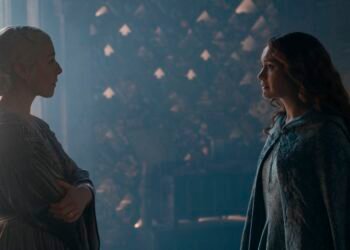Just like He-Man’s Power Sword in the Masters of the Universe sequel show Revelation, the series itself was split in half, with the first half airing in July 2021, and the second held for November release. Netflix was lucky enough to find an organic midpoint for the break in Kevin Smith’s animated throwback, even though the show was written as a single season. The first half did end on a pair of major cliffhangers, and the concluding five episodes only make good on half of the midpoint’s initial promise. But the second half of the series is incredibly worthwhile. It doesn’t flow as smoothly as part 1, and it skips a handful of vital emotional beats. But part 2 is so packed with enormous ideas that the episodes’ unevenness feels less like a bug, and more like an unavoidable feature.
[Ed. note: Significant spoilers ahead for part 1 of Masters of the Universe: Revelation.]
Even though Revelation is packaged as a Gen-X nostalgia act, it’s still primarily a children’s show. (Though not as much as Netflix’s other 2021 He-Man series, a full reboot aimed at a much younger audience.) Even so, Revelation’s second half matures in fascinating ways, mostly concerning Evil-Lyn (Lena Heady), Part 2’s MVP. At the same time, it keeps providing the goofy thrills expected from a series based on a line of toys.
Part 1 ended with the slain Prince Adam (Chris Wood) foregoing eternal paradise in order to help his friends, only to be stabbed by a returning Skeletor (Mark Hamill). By the mid-season finale, the show had set up both the possibility and the potential fallout of Adam dying a second time, knowing he only gets to come back from the dead once. But Part 2 finds a convenient way to sidestep the conundrum. While the quick resolution borders on a fake-out, Revelation answers its other lingering question with aplomb: What if the cackling, megalomaniacal Skeletor were to gain access to He-Man’s legendary power of Grayskull?

Image: Netflix
The resultant powered-up design is the kind of cool iteration designed to sell a new action figure to hardcore fans: Skeletor gets even bigger, grows a pair of ram horns, and has a neck made entirely of flames. His power-up is one of several What If… fantasies the show answers, not as fan-service (well, not only as fan-service), but in ways that usually provide some character-focused dilemma.
For instance: what would happen to Prince Adam if he called down “the power” without using his sword as a conduit, the way he always has in the past? The answer is brought to life through zippy, anime-inspired action, but this unhinged power fantasy paves the way for a deeply personal father-son story, while also informing one of Revelation’s major second-half themes: the nature of power, and the thin line between holding onto it and willingly giving it up.
Like that other 2021 He-Man reboot, Revelation wrestles with the basic premise of its 1980s predecessor, in which only one chosen warrior has “the power.” The show places significant narrative focus on the fact that as many times as Prince Adam has transformed into He-Man, he has reverted to his human form just as frequently, rather than remaining in super-powered He-Man form. When he ends up mindless and raging (based partially on the toy Wun-Darr, or “Savage He-Man”), it’s a whip-smart narrative trajectory, since it both prevents him from performing that graceful sacrifice again, and inadvertently aligns him with villains like Skeletor, who never willingly cede their power.
But while He-Man and Skeletor have more screen time in Part 2 than in Part 1, the story still largely belongs to the women who were their sidekicks in the original show. He-Man’s ally Teela (Sarah Michelle Gellar) is finally allowed to confront the secrets of her parentage — a narrative thread the ’80s show was never able to tie up. Unfortunately, her arc isn’t given the same time and care as it was in Part 1. She often rushes from beat to beat without struggling as much as she once did, even when faced with difficult ideas like maternal abandonment.
She undergoes a vast shift in status quo over the course of Revelation, and while it ends up being visually spectacular, it also comes far more easily than its setup would suggest. That’s arguably the biggest failing of Part 2. And yet this narrative sacrifice feels almost worthwhile, since more of the focus this time falls on Evil-Lyn, Skeletor’s second-in-command, and a character who ends up at the center of the show’s thematic musings on power.

Image: Netflix
Skeletor, using his newfound abilities, conscripts Lyn as the new Sorceress of Grayskull, a role that offers surprising new possibilities for the series. Among them is the power to witness the big picture of the universe itself — a universe Skeletor hopes to master, as the title suggests. The show presents that access via a dazzling visual display that also hits the series on a fundamental level, by introducing grandiose ideas like cosmic nihilism into what is essentially a kiddie cartoon. The reconciliation between these heady concepts and the whiz-bang action is often debonair, especially in the way the show entwines each larger theme with Lyn’s character arc and her complicated relationship to Skeletor. There’s an intriguing, melancholy form of apocalyptic villainy here.
The aesthetic expression of Lyn’s story is just as fascinating, from dreams and abstract visions meant to contextualize the enormity of her experience, to the change in her appearance during Part 2. Like the introduction of “Savage He-Man,” her changes function as a power fantasy, but also facilitate character evolution. She’s also afforded a unique physical appeal, the kind not often seen in modern children’s entertainment. (It was more common during the original He-Man.)
Her embrace of her new form feels much more meaningful than the usual ogling gaze of pinup fantasy, meant exclusively for straight men and teenage boys. There are scenes where her seductiveness takes center stage, but it’s a self-aware ploy, and her physical transformations feel almost on-par with He-Man’s, in terms of how chiseled and muscular the show allows her to be. She certainly goes beyond the most rigid standards of feminine beauty. When her outfits become more revealing, and more akin to ’80s metal album covers, they reveal physical might.
Teela’s father, the bearded, heavy-set Duncan/Man-At-Arms (Liam Cunningham), is afforded a similarly unconventional (and emotionally rooted) sensuality, with shirtless scenes that show off his broad and hairy torso while centering his soft-spoken vulnerability. Arguably, these more tantalizing designs are meant for the original show’s now-adult audience. But as with Part 1, writer, story editor, and executive producer Kevin Smith doesn’t seem to have adult nostalgia in mind, beyond a few minor hints of fan-service.
His narrative deals with complicated spiritual ideas, but simplifies them with younger viewers in mind. A key episode about ascendancy is titled “Comes With What You See Here,” as if to contextualize lineage through the language of a Mattel playset. While the original He-Man has a reputation as a straight male power fantasy, the visual appeal of some of the characters feels much broader in scope here, between Duncan’s bear-like appearance, and the butch hairdo Lyn ends up with (not unlike Teela’s in Part 1).

Image: Netflix
It’s a small tease for a queer reading of the show, but it’s only a tease. The supporting character Andra (Tiffany Smith), who shared a flirty dynamic with Teela in Part 1, is far less present in Part 2, which also speaks to the way Teela’s prior development is placed on the back burner in favor of a sped-up trajectory. However, both characters do end up at the center of some remarkable action sequences. One of the ways Part 2 improves on its predecessor is through its more varied setpieces, which are not only larger and more colorful, but flow with a more zestful energy, as Bear McCreary’s sweeping, adventurous score continues to pulsate.
What’s more, the action never feels like empty calories. In spite of an ever-growing arsenal of magical powers and technological accessories wielded against a faceless horde, the battles are always rooted in character beats, and punctuated by meaningful decisions — the kind that made the show worth following in the first place.
With bigger action, surprising allegiances, and good-vs.-evil dynamics centered around recognizable philosophies, Part 2 of Masters of the Universe: Revelation proves that familiar children’s adventure can still feel fresh, even when it takes the form of a 30-years-later nostalgia revival. While Part 2 is much messier than Part 1, its bumps are a byproduct of tackling strange and humongous narrative ideas that most children’s shows wouldn’t dream of touching, and it succeeds by wrapping them in shiny packaging.
Part 2 of Masters of the Universe: Revelation is streaming on Netflix now.
























































